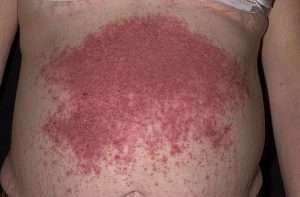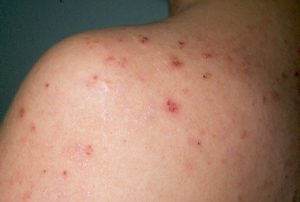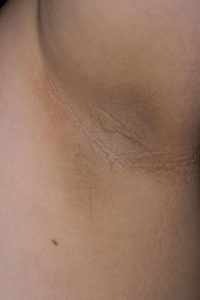18 Aug Is Your Child’s Rash Coming from Their Digestive System?
V arious skin rashes have been associated with specific diseases involving the digestive system. Sometimes, rashes will even appear well before symptoms involving the digestive tract. Being aware of these rashes may help your child be diagnosed sooner and on their way to recovery.
arious skin rashes have been associated with specific diseases involving the digestive system. Sometimes, rashes will even appear well before symptoms involving the digestive tract. Being aware of these rashes may help your child be diagnosed sooner and on their way to recovery.
What Is Dermatitis Herpetiformis?
Dermatitis herpetiformis is an extremely itchy rash that appears as bumps or blisters. The rash can be located on:
- elbows
- knees
-
 back
back
- neck
- belly
- bottom
- scalp
The rash can come and go over time.
What Causes Dermatitis Herpetiformis?
 Even though it sounds like it, the rash has nothing to do with herpes. Dermatitis herpetiformis occurs in people with celiac disease. Celiac disease is a disorder in which the digestion of gluten, the protein found in wheat, barley, and rye, leads to damage of the small intestine. The immune response that is triggered against gluten in the small intestine can also occur in the skin. Dermatitis herpetiformis occurs in up to 25% of people with celiac disease. Many people with dermatitis herpetiformis do not experience any digestive symptoms even though they have damage from gluten occurring in their digestive system.
Even though it sounds like it, the rash has nothing to do with herpes. Dermatitis herpetiformis occurs in people with celiac disease. Celiac disease is a disorder in which the digestion of gluten, the protein found in wheat, barley, and rye, leads to damage of the small intestine. The immune response that is triggered against gluten in the small intestine can also occur in the skin. Dermatitis herpetiformis occurs in up to 25% of people with celiac disease. Many people with dermatitis herpetiformis do not experience any digestive symptoms even though they have damage from gluten occurring in their digestive system.
What Is the Treatment for Dermatitis Herpetiformis?
The most effective treatment is strict adherence to a gluten-free diet after the diagnosis of celiac disease has been made.
If you are concerned that your child has dermatitis herpetiformis, then speak to your child’s physician about being evaluated for celiac disease.
What Is Acanthosis Nigricans?
 Acanthosis nigricans is a dark, scaly, velvety rash found in the folds and creases of the skin. The rash can be located on:
Acanthosis nigricans is a dark, scaly, velvety rash found in the folds and creases of the skin. The rash can be located on:
- neck
- armpits
- knees
- elbows
- palms
- soles of the feet
- groin
Acanthosis nigricans is not usually itchy but the affected skin may have an odor or mild itch.
What Causes Acanthosis Nigricans?
Acanthosis nigricans occurs when skin cells start to multiply rapidly in response to high levels on insulin in the blood. Carbohydrates that we eat are converted into sugar molecules such as glucose and fructose. The hormone insulin allows sugar to enter cells so the cells can use the sugar as energy. Any excess sugar is stored in the liver in the form of fat cells. Over time, the build up of fat cells in the liver due to excess sugar intake can lead to fatty liver disease. As this process continues to occur, the body will start to become resistant to insulin, and the levels of insulin and sugar will rise in your child’s bloodstream. The high insulin levels will cause normal skin cells to reproduce at a rapid rate leading to the development of a velvety rash, acanthosis nigricans. The majority of children with fatty liver disease have acanthosis nigricans.
What Is the Treatment for Acanthosis Nigricans?
The most effective treatment is following healthy nutrition and diet behaviors. All juices and sodas should be eliminated from the diet to avoid excess sugar intake. Acanthosis nigricans may fade over time as insulin resistance is reversed.
If you are concerned that your child has acanthosis nigricans, then speak to your child’s physician about being evaluated for fatty liver disease.
If you would like more information about gastrointestinal (GI) digestive disorders and nutrition in children, please contact Dr. Mona Dave’s Frisco Office or Request Appointment Here.